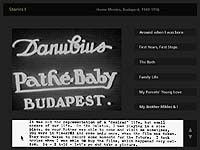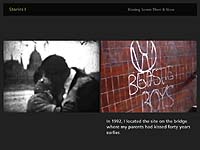


George Legrady's projects focus on the intersection of interactive narrative, interface metaphor design, cultural theory analysis, and the investigation of computer programming as aesthetic practice. Recent installations use motion detector sensors and machine vision by which to integrate audience presence as an active component in the narrative development.
George Legrady is professor of Interactive Media at Merz Akademie, Stuttgart and resides in San Francisco and Germany. Prior academic appointments were held at San Francisco State University, UCLA, University of Southern California, California Institute of the Arts and the University of Western Ontario. His interactive installations have recently been exhibited at the Museum of Contemporary Art, Los Angeles, the KunstHalle in Bonn, Haus der Kunst, Munich, Projects Studios One, New York, the National Gallery of Canada and the Palais des beaux-arts, Brussels. Recent awards include a National Endowment of the Arts Visual Fellowship, a Canada Council Computer Integrated Media Award in 1997 and 1994, the "New Voices, New Visions" prize from Voyager Co, and an Honorable Mention at Ars Electronica, Austria in 1994 and 1989.
CD-ROM publications include the National Gallery of Canada catalog "George Legrady: From Analogue to Digital", (1998); "Slippery Traces", in "Artintact 3", ZKM, Karlsruhe, Germany (1996); and "An Anecdoted Archive from the Cold War, HyperReal Media Production (1994).
Conceptual Description
An Anecdoted Archive from the Cold War is an interactive CD-ROM and computer-media installation project that explores the inscription of historical narrative through the process of archive construction. Born in Budapest in 1950 near the end of the Stalin era and having grown up in Canada in the sixties' counter culture movement, the Anecdoted Archive reflects my particular hybridized history in relation to the Cold War.
This non-linear features early 1950's East European, personal and official Communist material in the form of home movies, video footage of Eastern European places and events, objects, books, family documents, Socialist propaganda, money, sound recordings, news reports, identity cards, Western media reports, etc. They are part of my collection of things and stories related to the Cold War that I have gathered during the past 20 years. These items, in the form of over sixty stories, have been arranged thematically in eight rooms superimposed on the original floor plan of the former "Workers' Movement" museum in Budapest, the official propaganda museum of the Communist Party. The museum space currently houses the Peter Ludwig collection and the Museum of Contemporary Art. The original contents of the former museum have been placed into storage since 1990 or moved into the Museum of Contemporary History.
Concept
The project's primary intent was to give coherent form to the diverse set of references and "invested objects at hand" that defined my sense of history following the collapse of the Berlin wall which coincided with the death of my father. I am not a historian, sociologist, archivist or museologist but made use of methodologies borrowed from these disciplines to produce this interactive archive. It is not intended as an official history. It is rather about a way to situate stories through technological media. For instance, to create a platform where one's stories can engage in discourse with official history since one of the capabilities of the digitization process is that it reshapes information, erasing differences traditionally easily identifiable as belonging to official or personal narratives.
Another component of the project was to explore the transformation of narrative construction and the play between diverse ideological sub-texts effected through the impact of digital, non-linear media. Not only to produce a work that raises questions about the politics of story telling but also to consider the politics of audience reading. Based on chance, and the choices that viewers follow, each viewer walks away with a slightly different story from this Archive based according to their own ideological beliefs (family life, communist propaganda, pro-Western, etc.) In other words, the sequence and choices that each viewer selects becomes a visible reflection of their own cultural/political perspectives.
Interactive media and the digital environment are dependent on metaphor as the mode by which information, transformed back and forth from screen to memory, are given meaning. The Anecdoted Archive narrative also functions through a recognizable metaphor that makes access to the information meaningful: the museum as an architectural model and the museum floorplan as a conceptual space. This reference charges the objects and stories in the work as the metaphor reference reminds us of the museum's cultural function, as a site of memory for the inscription of the social collective imagination and as a site of representation and power.
